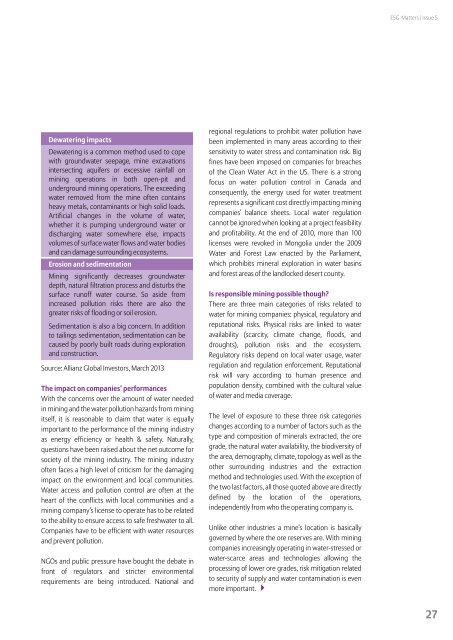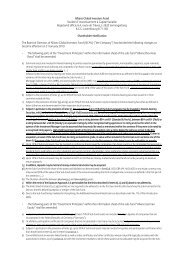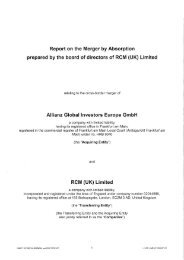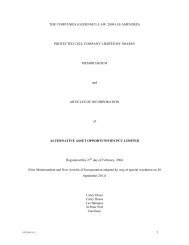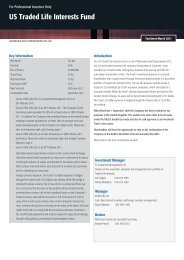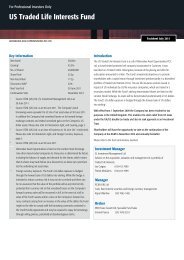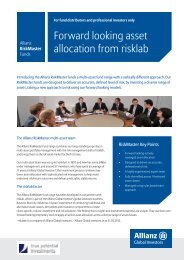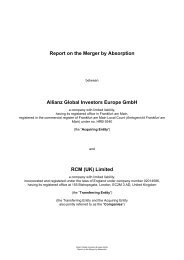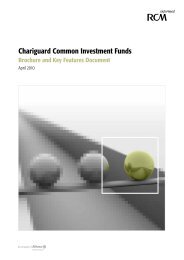ESG Matters, Issue 5, April 2013 - Allianz Global Investors
ESG Matters, Issue 5, April 2013 - Allianz Global Investors
ESG Matters, Issue 5, April 2013 - Allianz Global Investors
Create successful ePaper yourself
Turn your PDF publications into a flip-book with our unique Google optimized e-Paper software.
<strong>ESG</strong> <strong>Matters</strong> | <strong>Issue</strong> 5Dewatering impactsDewatering is a common method used to copewith groundwater seepage, mine excavationsintersecting aquifers or excessive rainfall onmining operations in both open-pit andunderground mining operations. The exceedingwater removed from the mine often containsheavy metals, contaminants or high solid loads.Artificial changes in the volume of water,whether it is pumping underground water ordischarging water somewhere else, impactsvolumes of surface water flows and water bodiesand can damage surrounding ecosystems.Erosion and sedimentationMining significantly decreases groundwaterdepth, natural filtration process and disturbs thesurface runoff water course. So aside fromincreased pollution risks there are also thegreater risks of flooding or soil erosion.Sedimentation is also a big concern. In additionto tailings sedimentation, sedimentation can becaused by poorly built roads during explorationand construction.Source: <strong>Allianz</strong> <strong>Global</strong> <strong>Investors</strong>, March <strong>2013</strong>The impact on companies’ performancesWith the concerns over the amount of water neededin mining and the water pollution hazards from miningitself, it is reasonable to claim that water is equallyimportant to the performance of the mining industryas energy efficiency or health & safety. Naturally,questions have been raised about the net outcome forsociety of the mining industry. The mining industryoften faces a high level of criticism for the damagingimpact on the environment and local communities.Water access and pollution control are often at theheart of the conflicts with local communities and amining company’s license to operate has to be relatedto the ability to ensure access to safe freshwater to all.Companies have to be efficient with water resourcesand prevent pollution.NGOs and public pressure have bought the debate infront of regulators and stricter environmentalrequirements are being introduced. National andregional regulations to prohibit water pollution havebeen implemented in many areas according to theirsensitivity to water stress and contamination risk. Bigfines have been imposed on companies for breachesof the Clean Water Act in the US. There is a strongfocus on water pollution control in Canada andconsequently, the energy used for water treatmentrepresents a significant cost directly impacting miningcompanies’ balance sheets. Local water regulationcannot be ignored when looking at a project feasibilityand profitability. At the end of 2010, more than 100licenses were revoked in Mongolia under the 2009Water and Forest Law enacted by the Parliament,which prohibits mineral exploration in water basinsand forest areas of the landlocked desert county.Is responsible mining possible though?There are three main categories of risks related towater for mining companies: physical, regulatory andreputational risks. Physical risks are linked to wateravailability (scarcity, climate change, floods, anddroughts), pollution risks and the ecosystem.Regulatory risks depend on local water usage, waterregulation and regulation enforcement. Reputationalrisk will vary according to human presence andpopulation density, combined with the cultural valueof water and media coverage.The level of exposure to these three risk categorieschanges according to a number of factors such as thetype and composition of minerals extracted, the oregrade, the natural water availability, the biodiversity ofthe area, demography, climate, topology as well as theother surrounding industries and the extractionmethod and technologies used. With the exception ofthe two last factors, all those quoted above are directlydefined by the location of the operations,independently from who the operating company is.Unlike other industries a mine’s location is basicallygoverned by where the ore reserves are. With miningcompanies increasingly operating in water-stressed orwater-scarce areas and technologies allowing theprocessing of lower ore grades, risk mitigation relatedto security of supply and water contamination is evenmore important. 27


